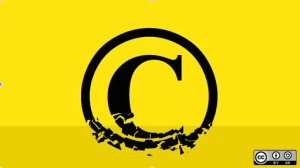Editor’s Note: The resources featured in this post were curated by Help Desk staff member Trevor Arsenault. Through the research he conducted for this post, Trevor learner about the importance of copyright and providing attribution to the authors of creative works. This was the perfect topic for Trevor, since he plans to attend the New England Art Institute and major in digital arts and graphic design.
Why Can’t I Just Take It?
In the modern technological age, one cannot simply take content from the internet without running the risk of being subject to copyright law violation. Taking such things as images, audio, or any type of media without the original author’s permission or proper citation is not only an example of irresponsible digital citizenship, it can be considered a felony. Infringement of copyright may carry serious penalties, such as fines and even incarceration. To avoid such crimes, websites exist that scour the internet for available creative content that is legal to use and share. One of the best sites that does this, is Creative Commons. This is a site dedicated to protecting the creators of intellectual property. It promotes a shared culture of learning, with a special emphasis on providing content creators with the steps they need to follow in order to license their work. Additionally, it is a site where you can find creative works that are legal to use, remix, and share. If teachers are assigning students projects that involve using digital media from the internet, including images, clip art, and music, they should first direct them to the “Find CC Licensed Works” of the Creative Commons website. Students will be able to search sites such as Flickr, Wikimedia Commons, Sound Cloud, CC Mixter, Google Images, Pixabay and more to find creative content for use in school projects. Part of responsible digital citizenship is respecting the creative works of others as well as the law! Understanding copyright can be somewhat confusing, but students and teachers should still familiarize themselves with creative commons licenses.
Creative Commons Resources:If you’re not familiar with how Creative Commons works, it can be somewhat confusing. The infographic below, created by Martin Missfeldt, does a nice job of clearly and simply defining each of the six types of Creative Commons licenses.
Below are the definitions of each type of license as stated on the Creative Commons Website:
CC 3.0- Attribution“This license lets others remix, tweak, distribute, and build upon your work. Commercially or not, in order to tweak and use or distribute but you have to credit the original creator of said content.”
CC BY-ND Attribution-NoDerivs“This license allows for redistribution, commercial and non-commercial, as long as it is passed along unchanged and in whole, with credit to you.”
CC BY-NC-SA Attribution-NonCommercial-ShareAlike“This license lets others remix, tweak, distribute, and build upon your work non-commercially. but you have to credit the original creator of said content.”
CC BY-SA Attribution-ShareAlike“This license lets others remix, tweak, and build upon your work even for commercial purposes, as long as they credit you and license their new creations under the identical terms. This license is often compared to “copyleft” free and open source software licenses. All new works based on yours will carry the same license, so any derivatives will also allow commercial use.”
CC BY-NC Attribution-NonCommercial“This license lets others remix, tweak, and build upon your work non-commercially, and although their new works must also acknowledge you and be non-commercial, they don’t have to license their derivative works on the same terms.”
CC BY-NC-ND Attribution-NonCommercial-NoDerivs“This license is the most restrictive of our six main licenses, only allowing others to download your works and share them with others as long as they credit you, but they can’t change them in any way or use them commercially.”
Public Domain:“When a work is in the public domain, it is free for use by anyone for any purpose without restriction under copyright law. Public domain is the purest form of open/free, since no one owns or controls the material in any way.”
Copyright and Fair Use Guidelines for Teachers
In the classroom, teachers have a bit more wiggle room concerning copyright because the work is generally for educational purposes and no profit will be made through the use of the work. But just to be on the safe side, this two-page chartprovides teachers with an overview of what they can and cannot do with copyrighted material. In terms of where to find images, below is a comprehensive list of links listed by subject area that we’ve curated, or you can check out any of thesesites. We hope you find these resources useful as you continue to create with digital media and promote responsible digital citizenship within your classroom.
Social Studies and History related:
U.S. Government Photos and Images The Library of Congress’ PhotosetsMilitary Photos, Pictures, Images and FormsAmerican Memory from the Library of CongressFarm Security Administration/Office of War Information color PhotographsClip Art For Students Including Globes and FlagsImages of Americans Political HistoryImages From the History of Medicine
Science and Biology related:
Health and physical education
Finances/Business
A Shared Culture of Learning:The video below explains in clear and simple terms the benefits of sharing digital content through a Creative Commons license.





Thanks for sharing information how Burlington teachers are address CC and Copyright with the students. I am curious about the "two page chart" link under the Copyright and Fair Use Guidelines for Teachers section. Would that PDF have been the Technology & Learning table? I ask as the link does not work.
ReplyDeleteHey Dean - Sorry about that. Here is the link - https://drive.google.com/file/d/0B-23Sf51QwgXQk1JeVhVYVFnYnVTTDMya3R6RTNncGQ5a2hn/edit?usp=sharing
ReplyDelete